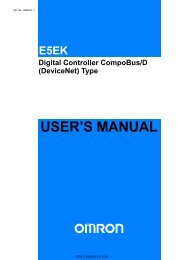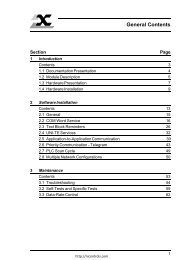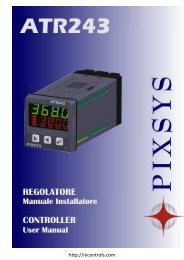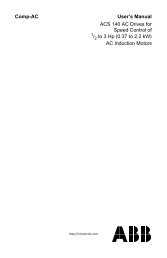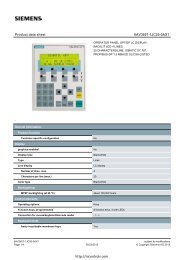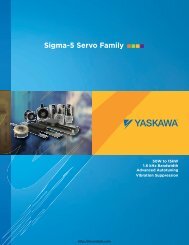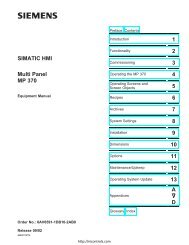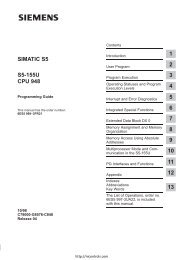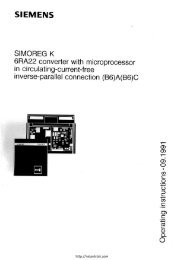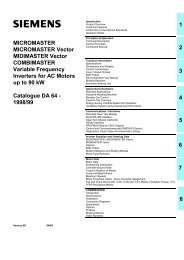Telemecanique Altivar 56 manual - Northern Industrial
Telemecanique Altivar 56 manual - Northern Industrial
Telemecanique Altivar 56 manual - Northern Industrial
Create successful ePaper yourself
Turn your PDF publications into a flip-book with our unique Google optimized e-Paper software.
Chapter 5 — ConfigurationBulletin No. 50006-519-01B1 →Parameter Setting Menu December 1996The factory preset value of Damping is 20% which corresponds to 1.5 times thefactory set motor inertia for the selected motor power rating. Most applications donot require Damping adjustment.If the motor speed oscillates or overshoots the desired speed during changes in themotor speed reference or during steady-state operation with constant load,Damping is set too low and should be increased.If the motor speed follows the speed reference ramp sluggishly or tends to varyduring steady-state operation with constant load, Damping is set too high andshould be decreased.ProfileProfile is used only when the drive controller is configured for Normal controltype. This parameter shapes the V/Hz profile of the output. Profile can be set to avalue between 0 and 100, factory preset to 20.During changes in speed command, the V/Hz profile becomes linear, intersectingthe Vn and fn points of Figure 36. As a result, there is no reduction in availablemotor torque during speed changes.VVn1000fnfmaxf (Hz)Shaded area denotes zonewithin which drive functionswhen Profile is set between0 and 100.Figure 36: ProfileProfile is not available when NOLD control type is selected.Motor OverloadCAUTIONMOTOR OVERHEATINGThis drive controller does not provide direct thermal protection for the motor. Use of athermal sensor in the motor may be required for protection at all speeds or loadingconditions. Consult motor manufacturer for thermal capability of motor when operatedover desired speed range.Failure to follow this instruction can result in injury or equipment damage.Motor Overload enables the drive controller to protect a standard induction motorfrom overload. This function can replace a conventional thermal overload relay forsingle motor applications; however, multi-motor applications require individualexternal thermal overload motor protection.This function is more effective in protecting a motor operated from a drivecontroller because it considers motor speed as well as time and current in itsprotection algorithm. This is important since most motors applied on drivecontrollers are self-cooled, and their cooling effectiveness declines at lower speeds.The drive controller’s protection algorithm integrates motor current over time,taking into account factors such as stop time and idle time. Two types of motoroverload protection can be selected from the 7.4→Fault Management menu (page100 for details):1. For Self-Cooled Motor (factory setting)2. No thermal protection60 © 1996 Square D All Rights Reservedηττπ://νιχοντρολσ.χοm




